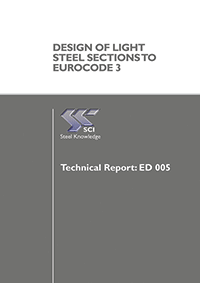Technical
Matters of principle – Part two
In Part One Alastair Hughes outlined the distinction between Principles and Application Rules in Eurocode design philosophy. Part Two picks out some examples from Eurocodes 3 and 4 and discusses the importance of the distinction in practice
Principles of Eurocode 3
Turning to EN 1993-1-1, two examples of Principles can be found under the heading 5.1 Structural modelling for analysis:
(1) P Analysis shall be based upon calculation models of the structure that are appropriate for the limit state under consideration. (2) The calculation model and basic assumptions for the calculations should reflect the structural behaviour at the relevant limit state with appropriate accuracy and reflect the anticipated type of behaviour of the cross sections, members, joints and bearings. (3) P The method used for the analysis shall be consistent with the design assumptions. (4) B For the structural modelling and basic assumptions for components of buildings see also EN 1993-1-5 and EN 1993-1-11.
It is far from obvious why 1 and 3 are Principles but 2 is not. Indeed, might it not be argued that 2 could stand alone and sufficient as the Principle, as 1 and 3 have little if anything to add? And might 4 exemplify a clause which is neither Principle nor Application Rule? It could almost be a NOTE.
A conscientious user of the Eurocodes will surely discover more cases of Principles masquerading as Application Rules and vice versa, and begin to wonder how much it matters. The same thought must have crossed the minds of their creators; rumour has it that at least one Part came out in draft without any identified Principles, and had to be hastily reissued with a smattering of ‘P’s inserted. In the bulk of EN 1993-1-1 Parts 5 and 6, the ‘P’ designation is routinely applied to the standard ‘effect not to exceed resistance’ formulations but otherwise rare.
Principles of Eurocode 4
Eurocode 4, which generally comes top of its class for clarity of writing and adherence to the rulebook, contains at least one questionable ‘Principle’, in EN 1994-1-1 6.7.1(1):
P Clause 6.7 applies for the design of composite columns and composite compression members with concrete encased sections, partially encased sections and concrete filled rectangular and circular tubes, see Figure 6.17.
That might more accurately be described as a scope limitation, one of many, some but not all of which are dignified by the P prefix. But further down, in subclause 5, we find:
Composite columns or compression members of any cross-section should be checked for: – resistance of the member in accordance with 6.7.2 or 6.7.3, – resistance to local buckling in accordance with (8) and (9) below, – introduction of loads in accordance with 6.7.4.2 and – resistance to shear between steel and concrete elements in accordance with 6.7.4.3.
which does seem like a Principle – everything listed must be verified. Perhaps the references to relevant Application Rules disqualify it from that status.
There is also a whole string of Principles in EN 1994-1-1 6.7.2, a clause which only applies to one of two alternative design methods, the other of which is in 6.7.3. Do the Principles of 6.7.2 apply to the method of 6.7.3? If not, can they really deserve the designation P?
A classic example of the statement of a principle, followed immediately by permission to (mostly) neglect it, can be found in EN 1994-1-1 5.4.2.4 (1)P and (2), on the subject of accounting (or not) for construction sequence.
These examples are chosen almost at random, and more could easily be picked up by anyone with the inclination and the time to trawl through the Eurocodes in search of anomalies. But perhaps the take-home message is that code rules will never divide neatly into Principles and Application Rules; they take their place on a spectrum, with Newton’s laws at one end and scope limitations or matters of fact at the other.
It’s almost like classifying connections as Rigid or Simple (limp). Virtually all practical connections are something in between. In the realm of frame design it can be claimed that the classification, though idealistic, is helpful nonetheless. Whether the same can be said of the Principles/Application Rules distinction is a moot point. To put this question another way, would users be seriously, or at all, disadvantaged if those Ps after the clause numbers were printed in white ink instead of the red that we have given them in this article?
Does the distinction between Principles and Application Rules matter?
In the early days of the European Project, international consensus was not always easy. It was convenient to be able to reassure those who lost the argument, or were outvoted, that they would be free to adopt ‘alternative design rules’ in place of unfamiliar or unpalatable Application Rules. Subclause (5) in EN 1990 1.4 (reproduced in Part One of this article) legitimizes such substitutions, provided that they accord with relevant Principles and deliver equivalent safety etc. ‘Don’t worry; we aren’t going to force you to drive on the right’, so to speak. Much opposition was neutralized in this way. The sting came later, when the NOTE was inserted directly after that subclause:
NOTE If an alternative design rule is substituted for an application rule, the resulting design cannot be claimed to be wholly in accordance with EN 1990 although the design will remain in accordance with the Principles of EN 1990. When EN 1990 is used in respect of a property listed in an Annex Z of a product standard or an ETAG, the use of an alternative design rule may not be acceptable for CE Marking.
NOTEs are informative, not normative, but this one is quite threatening: if you want the CE Mark, follow the official Application Rules.
So now a distinction is drawn between a design which is ‘wholly in accordance with EN 1990’ and a design which is merely in accordance with its Principles.
Where does this leave us? If we must have a CE Mark, must we obey the Application Rules? Arguably this means that in practice the distinction between Principles and Application Rules ceases to be worth notice. We can, of course, stop fretting over any questionable designations but that’s cold comfort.
Advice from BCSA is that client agreement can provide an escape route. One of the four different methods for CE Marking given in EN 1090-1 allows any design method (even BS 5950) to be used, subject to agreement with the client. So prudent designers will obtain explicit client agreement as a matter of course. Designers of ‘kit’ structures (predesigned buildings, towers, temporary bridging and the like) are in a more difficult position. As would we all, were the system to decide that this is a loophole and needs closing.
Conclusions
The distinction between Principles and Application Rules is much less important than it first appears, but this is because of the way the European Design Standards and Product Directives interact. To qualify for a CE Mark it may be necessary to conform with Eurocode Application Rules, not just Principles. Remember CE Marking became mandatory in July! Supplementary design rules (from NCCI or of the designer’s own devising) may only be permissible if they do not conflict with anything normative in the Standard. That is the official vision, even if it seems disconnected from reality.
Even if the CE Marking aspect is put to one side, it does seem fair to suggest that if the Principles / Application Rules distinction is to be retained in the next generation of Eurocodes it needs to be expressed in a much more consistent manner than hitherto. Alternatively, let it fade away unmourned.










